Page 171 of 317

�µ
�µ �µ
If you have done all of the above and
still cannot move the lever out of
Park, see Shif t Lock Release on page
.
You must also press the release
button to shift into Park. To avoid
transmission damage, come to a
complete stop bef ore shif ting into
Park. The shif t lever must be in Park
bef ore you can remove the key f rom
the ignition switch. To shif t to Reverse
f rom Park, see the explanation under
Park. To shif t to Reverse f rom
Neutral, come to a complete stop and
then shift. Press the release button
bef ore shif ting into Reverse f rom
Neutral.
Use Neutral if you
need to restart a stalled engine, or if
it is necessary to stop brief ly with
the engine idling. Always shif t to
Park position if you need to leave the
car f or any reason. Press on the
brake pedal when you are moving
the shift lever from Neutral to
another position. Use this position f or
your normal driving. The transmis-
sion automatically adjusts to keep
the engine at the best speed f or
driving conditions. To help the
engine warm up f aster, the transmis-
sion will select ratios that allow the
engine to run at higher speeds when
it is cold.
170
Driving
Reverse (R)
Neutral (N) Drive (D)
Automatic Transmission (CVT)
168
Page 174 of 317
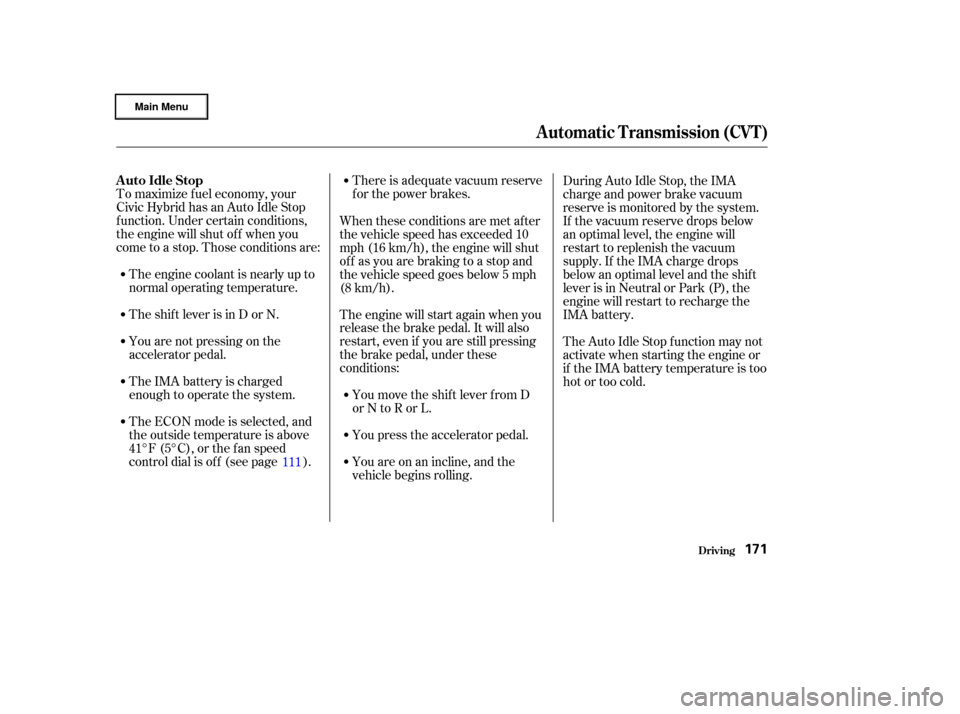
The engine coolant is nearly up to
normal operating temperature.
The shift lever is in D or N.
You are not pressing on the
accelerator pedal.There is adequate vacuum reserve
f or the power brakes.
To maximize f uel economy, your
Civic Hybrid has an Auto Idle Stop
f unction. Under certain conditions,
the engine will shut of f when you
come to a stop. Those conditions are:
The IMA battery is charged
enough to operate the system.
The ECON mode is selected, and
the outside temperature is above
41°F (5°C), or the f an speed
controldialisoff (seepage ). When these conditions are met af ter
the vehicle speed has exceeded 10
mph (16 km/h), the engine will shut
of f as you are braking to a stop and
the vehicle speed goes below 5 mph
(8 km/h).
The engine will start again when you
release the brake pedal. It will also
restart, even if you are still pressing
the brake pedal, under these
conditions:
You are on an incline, and the
vehicle begins rolling. You press the accelerator pedal.
You move the shif t lever f rom D
or N to R or L. During Auto Idle Stop, the IMA
charge and power brake vacuum
reserve is monitored by the system.
If the vacuum reserve drops below
an optimal level, the engine will
restart to replenish the vacuum
supply. If the IMA charge drops
below an optimal level and the shif t
lever is in Neutral or Park (P), the
engine will restart to recharge the
IMA battery.
The Auto Idle Stop f unction may not
activate when starting the engine or
if the IMA battery temperature is too
hot or too cold.
111
Driving
Automatic Transmission (CVT)
Auto Idle Stop
171
Page 175 of 317
The indicator blinks as a reminder
that the engine has stopped because
of the Auto Idle Stop f unction. You
cannot restart the engine with the
ignition switch when this light is
blinking.If you open the driver’s door when
Auto Stop is active, the indicator will
blink and you will hear a continuous
beep. The beep will stop when you
close the door.
With the driver’s door open, you will
hear a continuous beep even if the
Auto Idle Stop f unction is
deactivated and the engine restarts.
Always turn the ignition switch to
LOCK (0) and remove the key if you
are getting out of the car.
Driving
A uto Idle Stop Indicator
Automatic Transmission (CVT)
172
AUTO IDLE STOP INDICATOR
Page 207 of 317
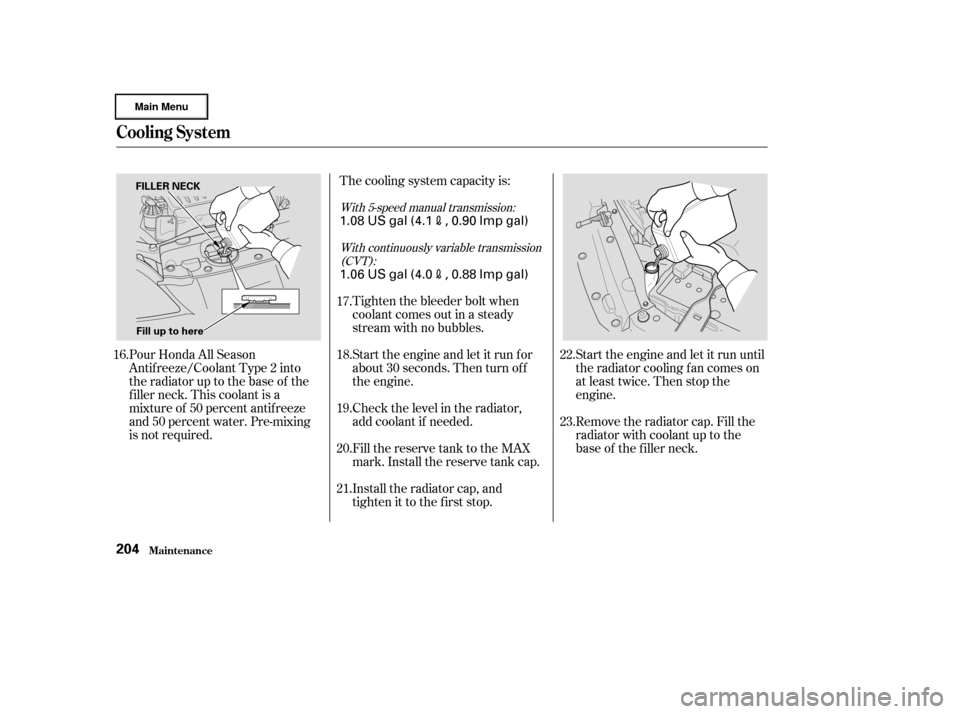
Start the engine and let it run until
the radiator cooling f an comes on
at least twice. Then stop the
engine.
Remove the radiator cap. Fill the
radiator with coolant up to the
base of the f iller neck.
The cooling system capacity is:
Tighten the bleeder bolt when
coolant comes out in a steady
stream with no bubbles.
Start the engine and let it run f or
about 30 seconds. Then turn of f
the engine.
Check the level in the radiator,
add coolant if needed.
Fill the reserve tank to the MAX
mark. Install the reserve tank cap.
Install the radiator cap, and
tighten it to the first stop.
Pour Honda All Season
Antif reeze/Coolant Type 2 into
the radiator up to the base of the
f iller neck. This coolant is a
mixture of 50 percent antif reeze
and 50 percent water. Pre-mixing
is not required.
16.
17.
18.
19.
20.
21.22.
23.
With 5-speed manual transmission:
With continuously variable transmission(CVT):
Cooling Syst em
Maint enance204
FILLER NECK
Fill up to here
1.08 US gal (4.1, 0.90 Imp gal)
1.06 US gal (4.0
, 0.88 Imp gal)
Page 208 of 317
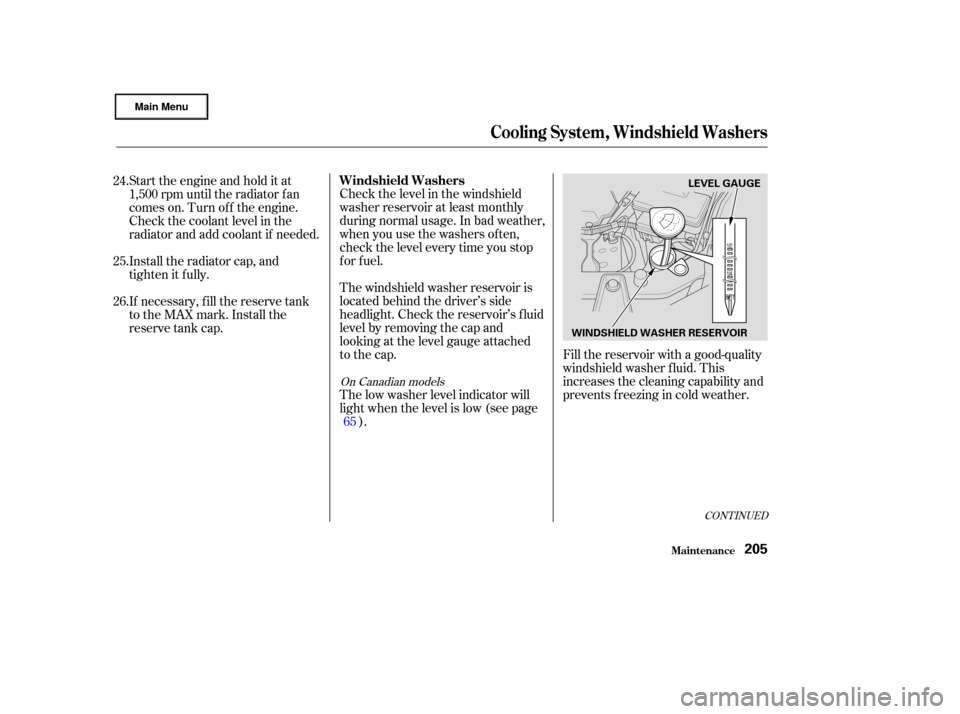
Fill the reservoir with a good-quality
windshield washer f luid. This
increases the cleaning capability and
prevents f reezing in cold weather.
Check the level in the windshield
washer reservoir at least monthly
during normal usage. In bad weather,
when you use the washers of ten,
check the level every time you stop
for fuel.
The windshield washer reservoir is
located behind the driver’s side
headlight. Check the reservoir’s f luid
level by removing the cap and
looking at the level gauge attached
to the cap.
The low washer level indicator will
light when the level is low (see page
).
Start the engine and hold it at
1,500 rpm until the radiator f an
comes on. Turn of f the engine.
Check the coolant level in the
radiator and add coolant if needed.
Install the radiator cap, and
tighten it fully.
If necessary, f ill the reserve tank
to the MAX mark. Install the
reserve tank cap.
65
24.
25.
26.
On Canadian models
CONT INUED
Maint enance
Cooling System, Windshield Washers
Windshield Washers
205
LEVEL GAUGE
WINDSHIELD WASHER RESERVOIR
Page 273 of 317
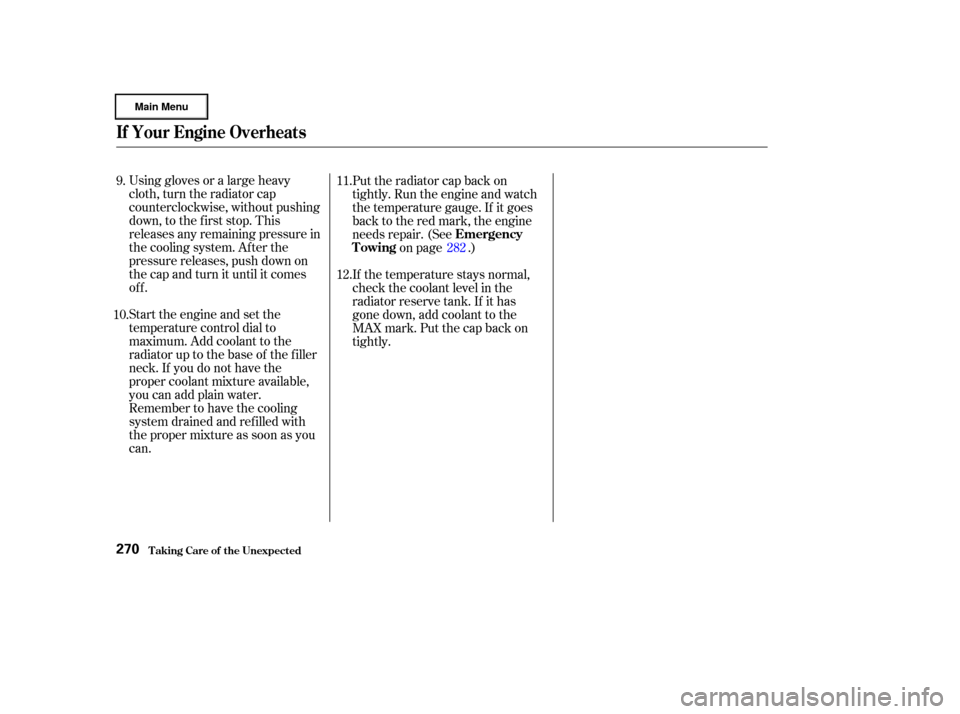
Using gloves or a large heavy
cloth, turn the radiator cap
counterclockwise, without pushing
down, to the f irst stop. This
releases any remaining pressure in
the cooling system. After the
pressure releases, push down on
the cap and turn it until it comes
off.
Start the engine and set the
temperature control dial to
maximum. Add coolant to the
radiator up to the base of the f iller
neck. If you do not have the
proper coolant mixture available,
you can add plain water.
Remember to have the cooling
system drained and ref illed with
the proper mixture as soon as you
can.Put the radiator cap back on
tightly. Run the engine and watch
the temperature gauge. If it goes
back to the red mark, the engine
needs repair. (See
on page .)
If the temperature stays normal,
check the coolant level in the
radiator reserve tank. If it has
gone down, add coolant to the
MAX mark. Put the cap back on
tightly.
9.
10. 11.
12.
282
T aking Care of t he Unexpect ed
If Your Engine Overheats
Emergency
Towing
270
Page 274 of 317
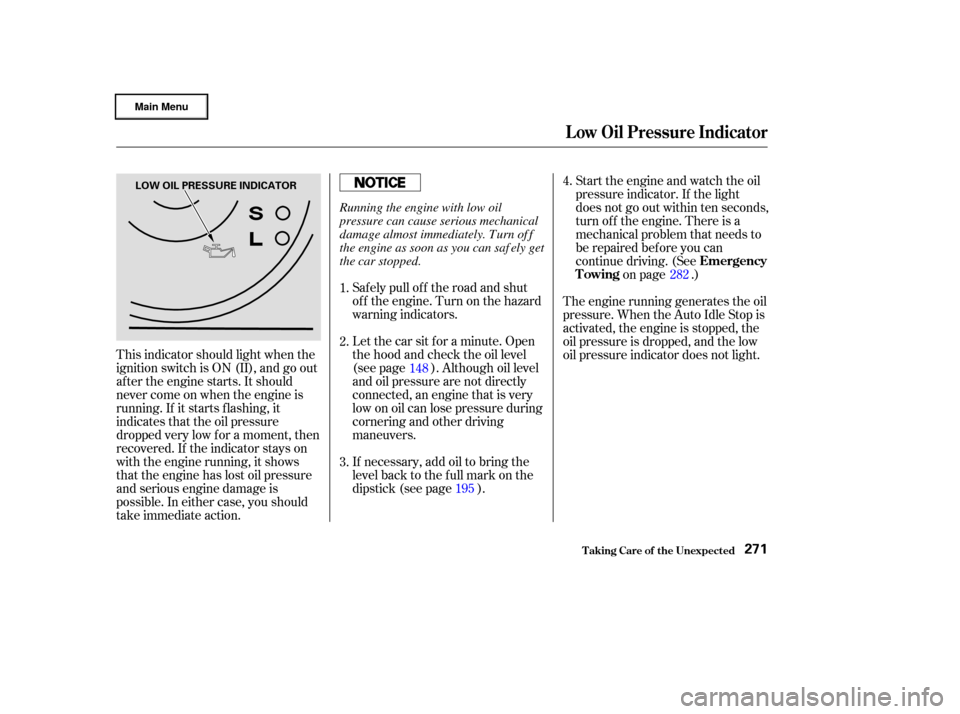
This indicator should light when the
ignition switch is ON (II), and go out
af ter the engine starts. It should
never come on when the engine is
running. If it starts f lashing, it
indicates that the oil pressure
dropped very low f or a moment, then
recovered. If the indicator stays on
with the engine running, it shows
that the engine has lost oil pressure
and serious engine damage is
possible. In either case, you should
take immediate action.Saf ely pull of f the road and shut
of f the engine. Turn on the hazard
warning indicators.
If necessary, add oil to bring the
level back to the full mark on the
dipstick (see page ). Letthecarsitforaminute.Open
the hood and check the oil level
(see page ). Although oil level
and oil pressure are not directly
connected, an engine that is very
low on oil can lose pressure during
cornering and other driving
maneuvers.Start the engine and watch the oil
pressure indicator. If the light
does not go out within ten seconds,
turn of f the engine. There is a
mechanical problem that needs to
be repaired bef ore you can
continue driving. (See
on page .)
The engine running generates the oil
pressure. When the Auto Idle Stop is
activated, the engine is stopped, the
oil pressure is dropped, and the low
oil pressure indicator does not light.
1.
2.
3. 4.
148 195 282
L ow Oil Pressure Indicator
T aking Care of t he Unexpect ed
Emergency
Towing
271
LOW OIL PRESSURE INDICATOR
Running the engine with low oil
pressure can cause serious mechanical
damage almost immediately. Turn of f
the engine as soon as you can saf ely get
the car stopped.
Page 275 of 317

�µ
�µ
This indicator should come on when
the ignition switch is ON (II), and go
out af ter the engine starts. If it
comes on brightly when the engine
is running, it indicates that the
charging system has stopped
charging the battery. Immediately turn of f all electrical
accessories: radio, heater, A/C, rear
def ogger, cruise control, etc. Try not
to use other electrically-operated
controls such as the power windows.
Keep the engine running and take
extra care not to stall it. Starting the
engine will discharge the battery
rapidly.
By eliminating as much of the
electrical load as possible, you can
drive several miles (kilometers)
before the battery is too discharged
to keep the engine running. Drive to
a service station or garage where
you can get technical assistance.
If the Auto Idle Stop is active f or an
extended period, the charging
system indicator may come on. If it
happens, start the engine.
The charging system indicator may
also come on if the Integrated Motor
Assist (IMA) battery charge drops
below a desired level and the engine
starts to recharge the battery.
This indicator may blink af ter you
start the car in the morning when
the temperature is below 20°F
( 30°C). It will stop blinking when
the IMA battery warms up.
T aking Care of t he Unexpect ed
Charging System Indicator
272
CHARGING SYSTEM INDICATOR